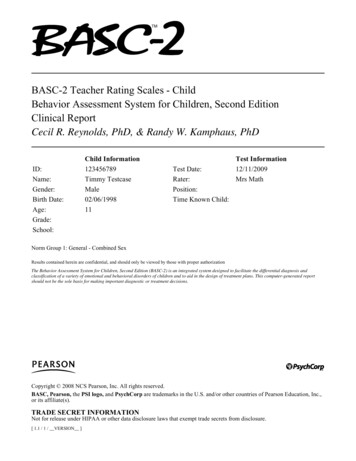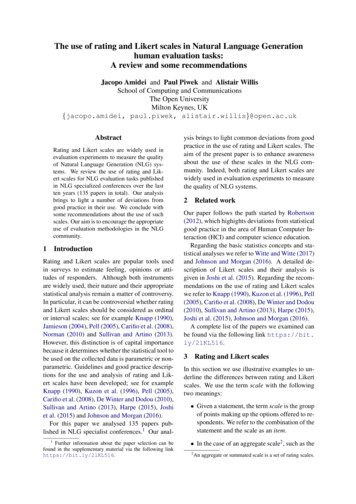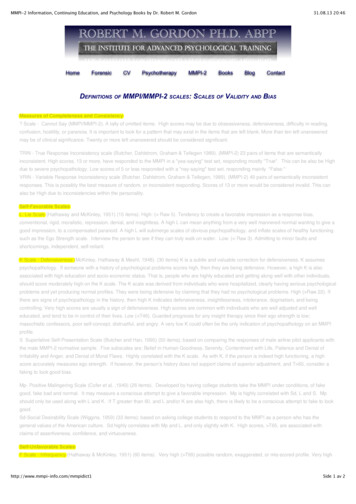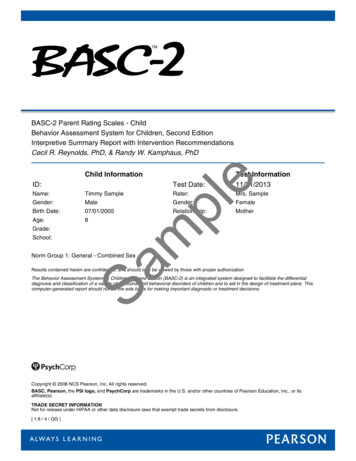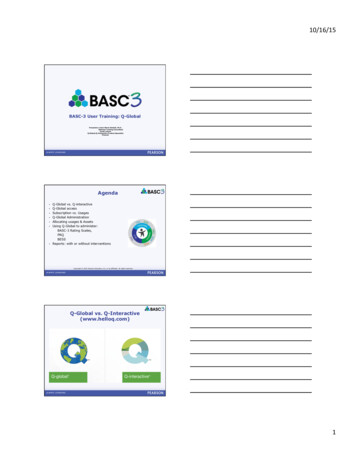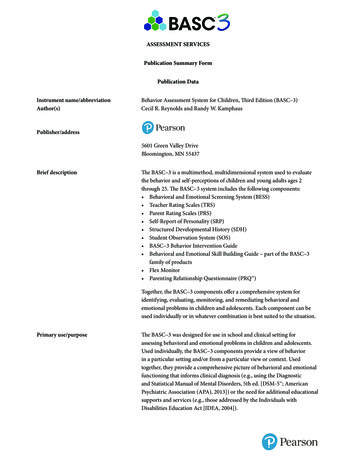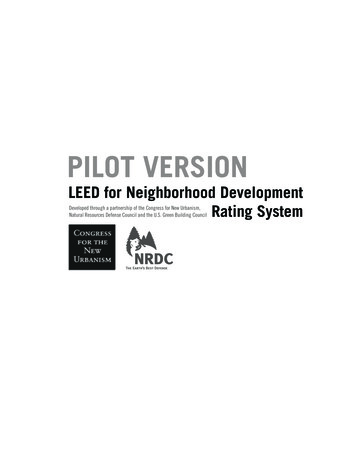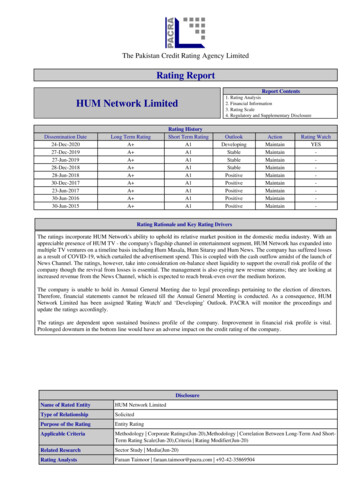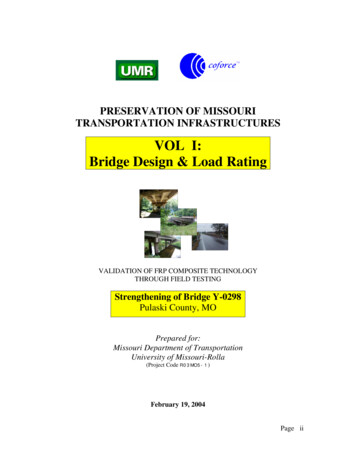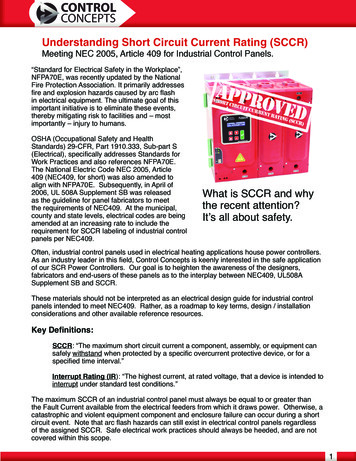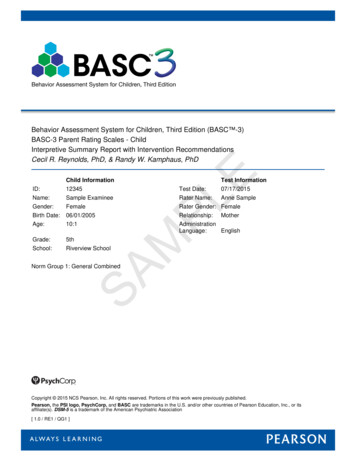
Transcription
EBehavior Assessment System for Children, Third Edition (BASC -3)BASC-3 Parent Rating Scales - ChildInterpretive Summary Report with Intervention RecommendationsCecil R. Reynolds, PhD, & Randy W. Kamphaus, PhDChild InformationName:Sample ExamineeGender:FemaleBirth Date:06/01/2005Age:10:1Grade:5thSchool:Riverview SchoolTest InformationTest Date:07/17/2015PL12345Rater Name:Anne SampleRater Gender: glishMID:SANorm Group 1: General CombinedCopyright 2015 NCS Pearson, Inc. All rights reserved. Portions of this work were previously published.Pearson, the PSI logo, PsychCorp, and BASC are trademarks in the U.S. and/or other countries of Pearson Education, Inc., or itsaffiliate(s). DSM-5 is a trademark of the American Psychiatric Association[ 1.0 / RE1 / QG1 ]
BASC -3 Parent Rating Scales - Child Interpretive Summary Report with Intervention Recommendations07/17/2015, Page 2COMMENTS AND CONCERNSSAMPLENo comments or concerns were provided.ID: 12345Sample Examinee
BASC -3 Parent Rating Scales - Child Interpretive Summary Report with Intervention Recommendations07/17/2015, Page 3ID: 12345Sample ExamineeVALIDITY INDEX SUMMARYF IndexResponse w Score: 0Raw Score: 130Raw Score: 10CLINICAL AND ADAPTIVE T-SCORE PROFILE120120110110100100CLINICALLY SIGNIFICANT90E9080PL807070AT-RISKT Score60M5040SA30605040AT-RISK30CLINICALLY thdrawalBehavioralSymptoms IndexAdaptabilitySocial SkillsLeadershipFunctionalCommunicationsActivities ofDaily LivingAdaptive 0669733819113789038326586534T Score (Plotted) General CombinedPercentileGeneral Combined20
BASC -3 Parent Rating Scales - Child Interpretive Summary Report with Intervention Recommendations07/17/2015, Page 4ID: 12345Sample ExamineeCLINICAL AND ADAPTIVE SCORE TABLE: General Combined Norm GroupComposite Score SummaryRaw ScoreT ScorePercentile Rank90% ConfidenceIntervalExternalizing Problems167578053-61Internalizing Problems169588154-62Behavioral Symptoms Index361649060-68Adaptive Skills234463443-49Composite ComparisonsExternalizing Problems vs. Internalizing ProblemsDifferenceSignificanceLevel-1NS60EMean T score of the BSIFrequency ofDifferenceMean T score of the Adaptive Skills CompositePLScale Score Summary47Ipsative ComparisonT ScorePercentileRank90% ency ofDifference22809973-87200.051% or lessAggression247Conduct calityWithdrawalAttention ProblemsAdaptabilitySocial SkillsLeadership4839-55-130.055% or less834-46-200.052% or less526646-58-8NS739767-79130.055% or less443338-50-160.0515% or less1% or NS533627-39-140.05Activities of Daily Living20556548-628NSFunctional Communication28535847-596NS1% or lessNote: All classifications of test scores are subject to the application of the standard error of measurement (SEM) when making classificationdecisions. Individual clinicians are advised to consider all case-related information to determine if a particular classification is appropriate. Seethe BASC-3 Manual for additional information on SEMs and confidence intervals.
BASC -3 Parent Rating Scales - Child Interpretive Summary Report with Intervention Recommendations07/17/2015, Page 5ID: 12345Sample ExamineeVALIDITY INDEX NARRATIVESThe BASC-3 F Index is a classically derived infrequency scale, designed to assess the possibility that a rater hasdepicted a child's behavior in an inordinately negative fashion. The F Index consists of items that representmaladaptive behaviors to which the rater answered "almost always" and adaptive behaviors to which the raterresponded "never."The F Index score produced from the ratings of Sample by Anne falls within the Acceptable range and does notindicate the presence of negative response distortion.The Consistency Index identifies situations when the rater has given inconsistent responses to items that aretypically answered in a similar way, based on comparisons made to raters from the general population. TheConsistency Index was designed to identify ratings that might not be easily interpretable due to these responsediscrepancies.SAMPLEThe Consistency Index score produced from the ratings of Sample by Anne falls within the Acceptable rangeand indicates the rater consistently answered items when completing the rating form.
BASC -3 Parent Rating Scales - Child Interpretive Summary Report with Intervention Recommendations07/17/2015, Page 6ID: 12345Sample ExamineeVALIDITY INDEX ITEM LISTSValidity Index ratings for F Index, D Index, Response Pattern Index, and Consistency Index are all Acceptable.F IndexThe F Index rating is Acceptable.Response Pattern IndexThe Response Pattern Index rating is Acceptable.Consistency IndexSAMPLEThe Consistency Index rating is Acceptable.
BASC -3 Parent Rating Scales - Child Interpretive Summary Report with Intervention Recommendations07/17/2015, Page 7ID: 12345Sample ExamineeCLINICAL AND ADAPTIVE SCALE NARRATIVESThis report is based on Anne Sample's rating of Sample's behavior using the BASC-3 Parent Rating Scales form.The narrative and scale classifications in this report are based on T scores obtained using norms. Scale scores inthe Clinically Significant range suggest a high level of maladjustment. Scores in the At-Risk range may identify asignificant problem that may not be severe enough to require formal treatment or may identify the potential ofdeveloping a problem that needs careful monitoring.Externalizing ProblemsThe Externalizing Problems composite scale T score is 57, with a 90% confidence interval range of 53-61 and apercentile rank of 80.Sample's T score on Hyperactivity is 80 and has a percentile rank of 99. This T score falls in the ClinicallySignificant classification range and usually warrants follow-up. Sample's mother reports that Sample engages inmany disruptive, impulsive, and uncontrolled behaviors.ESample's T score on Aggression is 47 and has a percentile rank of 48. Sample's mother reports that Sampletends not to act aggressively any more often than others of her age.PLSample's T score on Conduct Problems is 40 and has a percentile rank of 8. Sample's mother reports thatSample demonstrates rule-breaking behavior no more often than others her age.Internalizing ProblemsMThe Internalizing Problems composite scale T score is 58, with a 90% confidence interval range of 54-62 and apercentile rank of 81.Sample's T score on Anxiety is 52 and has a percentile rank of 66. Sample's mother reports that Sample displaysanxiety-based behaviors no more often than others her age.SASample's T score on Depression is 73 and has a percentile rank of 97. This T score falls in the ClinicallySignificant classification range and follow-up may be necessary. Sample's mother reports that Sample iswithdrawn, pessimistic, and/or sad. Scores in this range usually warrant assessment of vegetative symptoms(e.g., weight loss or gain, fatigue). Suicidal tendencies should also be explored.Sample's T score on Somatization is 44 and has a percentile rank of 33. Sample's mother reports that Samplecomplains of health-related problems to about the same degree as others her age.Behavioral Symptoms IndexThe Behavioral Symptoms Index (BSI) composite scale T score is 64, with a 90% confidence interval range of60-68 and a percentile rank of 90. Sample's T score on this composite scale falls in the At-Risk classificationrange. Scale summary information for Hyperactivity, Aggression, and Depression (scales included in the BSI) hasbeen provided above. Scale summary information for the remaining BSI scales is given next.Sample's T score on Atypicality is 41 and has a percentile rank of 13. Sample's mother reports that Samplegenerally displays clear, logical thought patterns and she is generally aware of her surroundings.Sample's T score on Withdrawal is 55 and has a percentile rank of 78. Sample's mother reports that Sampledoes not avoid social situations and appears to be capable of developing and maintaining friendships with others.Sample's T score on Attention Problems is 65 and has a percentile rank of 91. This T score falls in the At-Riskclassification range and follow-up may be necessary. Sample's mother reports that Sample has difficultymaintaining necessary levels of attention at school. The problems experienced by Sample might disrupt academicperformance and functioning in other areas.
BASC -3 Parent Rating Scales - Child Interpretive Summary Report with Intervention Recommendations07/17/2015, Page 8ID: 12345Sample ExamineeAdaptive SkillsThe Adaptive Skills composite scale T score is 46, with a 90% confidence interval range of 43-49 and apercentile rank of 34.Sample's T score on Adaptability is 47 and has a percentile rank of 38. Sample's mother reports that Sample isable to adapt as well as most others her age to a variety of situations.Sample's T score on Social Skills is 46 and has a percentile rank of 32. Sample's mother reports that Samplepossesses sufficient social skills and generally does not experience debilitating or abnormal social difficulties.Sample's T score on Leadership is 33 and has a percentile rank of 6. This T score falls in the At-Riskclassification range and follow-up may be necessary. Sample's mother reports that Sample sometimes hasdifficulty making decisions, lacks creativity, and/or has trouble getting others to work together effectively.ESample's T score on Activities of Daily Living is 55 and has a percentile rank of 65. Sample's mother reports thatSample is able to adequately perform simple daily tasks in a safe and efficient manner.SAMPLSample's T score on Functional Communication is 53 and has a percentile rank of 58. Sample's mother reportsthat Sample generally exhibits adequate expressive and receptive communication skills and that Sample isusually able to seek out and find new information when needed.
BASC -3 Parent Rating Scales - Child Interpretive Summary Report with Intervention Recommendations07/17/2015, Page 9ID: 12345Sample ExamineeBASC-3 PRS-C INTERVENTION RECOMMENDATIONSNote. Information contained in the Intervention Summary section of this report is based on the BASC-3 BehaviorIntervention Guide, authored by Kimberly J. Vannest, Cecil R. Reynolds, and Randy W. Kamphaus.Primary ImprovementAreas- Hyperactivity- DepressionSecondary ImprovementAreas- Leadership- Attention ProblemsAdaptive Skill Strengths- NoneSample's scores on Hyperactivity and Depression fall in the clinically significant range and probably should beconsidered among the first behavioral issues to resolve. Her score on Attention Problems is also elevated andmay warrant targeted interventions and/or further monitoring to ensure it doesn't worsen.ENote that Sample had a score on Leadership that is an area of concern. Interventions for this area are notprovided in this report. However, this area may require additional follow up.PLSample's BASC-3 profile indicates significant problems with Hyperactivity, Depression, and Attention Problems.Based on Anne Sample's ratings, Sample is experiencing problems with the following behaviors:DepressionSA- fiddling with things- interrupting others- disrupting others- having poor self-control- acting without thinking- being overly active- not waiting for turnMHyperactivity- getting easily upset- changing moods quickly- complaining about not being liked- being sad- being pessimistic- being lonelyAttention Problems- paying attention- listening well- staying focusedPrimary Improvement Area: HyperactivityHyperactivity problems are considered to be one of Sample's most significant behavioral and emotional areas toaddress. The DSM-5 lists symptoms such as fidgeting and squirming, leaving a seat unexpectedly, running orclimbing inappropriately, failing to stay quiet, having difficulty waiting for a turn, or frequently interrupting andintruding socially. Hyperactivity problems can occur alone or can co-occur with attention problems and are usuallyexhibited by children in both home and school settings.
BASC -3 Parent Rating Scales - Child Interpretive Summary Report with Intervention Recommendations07/17/2015, Page 10ID: 12345Sample ExamineeThere are a variety of interventions that have been shown to reduce, or have shown promise for reducing,hyperactive behavior, including: Contingency Management Daily Behavior Report Cards (DBRC) Functional Behavioral Assessment Multimodal Interventions Parent Training Self-Management Task ModificationEDetailed summaries of the Contingency Management and Self-Management intervention strategies are providedbelow. See the BASC-3 Behavior Intervention Guide for more information about these strategies and the otherintervention strategies listed above.Hyperactivity Intervention Option 1: Contingency ManagementMPLIn contingency management for hyperactivity, behavioral interventions are used to modify consequent events thatmaintain hyperactive and impulsive behavior. Contingency management involves shaping the child's existingbehavior and providing opportunities for the new, desired behavior to become internalized. Contingencymanagement programs for hyperactivity include the individual or combined use of behavioral interventionstrategies such as token economies; point systems; verbal praise; response cost; timeout from peers, reinforcers,attention, or privileges; varying amounts and frequency of teacher attention; verbal reprimands; and removal ofpraise. The goal of contingency management is to decrease the child's activity levels that negatively impactlearning by reshaping the environment to reinforce or eliminate behaviors.SAThe essential elements of Contingency Manage
Behavior Assessment System for Children, Third Edition (BASC -3) BASC-3 Parent Rating Scales - Child Interpretive Summary Report with Intervention Recommendations Cecil R. Reynolds, PhD, & Randy W. Kamphaus, PhD Norm Group 1: General Combined Child Information Test Information ID: 12345 Test Date: 07/17/2015 Name: Sample Examinee Rater Name: Anne Sample

